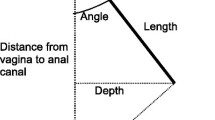Abstract
PURPOSE: Anal sphincter damage can occur during vaginal delivery and may lead to impairment of fecal continence. The aim of this study was to determine the influence of irritable bowel syndrome on symptoms of fecal incontinence following first vaginal delivery. METHODS: A prospective, observational study was performed before delivery, six weeks, and six months following delivery in primiparous women. A bowel function questionnaire was completed, and anal vector manometry, mucosal electrosensitivity, pudendal nerve terminal motor latency, and anal endosonography were performed. A total of 208 women were assessed before and after delivery, and 104 primigravid women were studied after delivery only. A total of 34 of 312 (11 percent) had an existing diagnosis of irritable bowel syndrome. RESULTS: The prevalence of abnormal manometry or endosonography was similar in women with and without irritable bowel syndrome. However, six weeks after delivery, women with irritable bowel syndrome had a higher incidence of defecatory urgency (64 percent) and loss of control of flatus (35 percent) compared with those without (urgency, 10 percent,P<0.001; flatus, 13 percent,P=0.007). The incidence of frank fecal incontinence was similar in the two groups. Women with IBS had increased mucosal sensitivity to electrical stimulation of the upper anal canal both before and after delivery. CONCLUSION: Women with IBS are more likely to experience subjective alteration of fecal continence postpartum compared with the healthy primigravid population, but they are not at increased risk of anal sphincter injury.
Similar content being viewed by others
References
Sultan AH, Kamm MA, Hudson CN, Bartram CI. Anal sphincter disruption during vaginal delivery. N Engl J Med 1993;329:1905–11.
Donnelly VS, Campbell DM, Johnson H, O'Connell PR, O'Herlihy C. Obstetric events leading to anal sphincter damage. Obstet Gynecol (in press).
Thompson WG, Dotevall G, Drossman DA, Heaton KW, Kruis W. Irritable bowel syndrome: guidelines for diagnosis. Gastroenterol Int 1989;2:92–5.
Perry RE, Blantchford GJ, Christensen MA, Thorson AG, Attwood SE. Manometric diagnosis of anal sphincter injuries. Am J Surg 1990;159:112–17.
Cornes H, Bartolo DC, Stirrat GM. Changes in anal canal sensation after childbirth. Br J Surg 1991;78:74–7.
Rogers J, Henry MM, Misiewicz JJ. Disposable pudendal nerve stimulation: evaluation of the standard instrument and new device. Gut 1988;29:1131–3.
Snooks JJ, Swash M. Nerve stimulation techniques. In: Henry MM, Swash M, eds. Coloproctology and the pelvic floor. London: Butterworths, 1985:112–28.
Campbell DM, Donnelly VS, Behan M, O'Herlihy C, O'Connell PR. Endosonographic assessment of postpartum anal sphincter injury using a 120 degree sector scanner. Clin Radiol 1996;51:559–61.
Snooks SJ, Swash M, Mathews SE, Henry MM. Effect of vaginal delivery on the pelvic floor: a 5 year follow up. Br J Surg 1990;77:1358–60.
Laurberg S, Swash M. Effects of ageing on the anorectal sphincters and their innervation. Dis Colon Rectum 1989;32:737–42.
Donnelly VS, Fynes M, O'Connell PR, O'Herlihy C. The influence of oestrogen replacement on faecal incontinence in post menopausal women. Br J Obstet Gynaecol 1997;104:311–5.
Drife JO. Choice and instrumental delivery. Br J Obstet Gynaecol 1996;103:608–11.
Leigh RJ, Turnberg LA. Faecal incontinence: the unvoiced symptom. Lancet 1982;1:1349–51.
Allen RE, Hosker GL, Smith AR, Warrell DW. Pelvic floor damage and childbirth: a neurophysiological study. Br J Obstet Gynaecol 1990;97:770–9.
Sultan AH, Kamm MA, Hudson CN. Pudendal nerve damage during labour: prospective study before and after childbirth. Br J Obstet Gynaecol 1994;101:22–8.
Snooks SJ, Swash M, Henry MM, Setchell M. Risk factors in childbirth causing damage to the pelvic floor innervation. Int J Colorectal Dis 1986;1:20–4.
Sultan AH, Stanton SL. Preserving the pelvic floor and perineum during childbirth—elective caesarean section. Br J Obstet Gynaecol 1996;103:731–4.
Hasler WL, Soudah HC, Owyawy C. Somatostatin analogue inhibits afferent response to rectal distension in diarrhoea-predominant irritable bowel patients. J Pharmacol Exp Ther 1994;268:1206–11.
Author information
Authors and Affiliations
Additional information
Funded by the research colleges of the National Maternity and Mater Misericordiae Hospitals, Dublin, Ireland.
Read, in part, at the meeting of the Irish Society of Gastroenterology, June 3 to 4, 1994, and poster presentation at the meeting of the European Council for Coloproctology, Barcelona, Spain, June 15 to 17, 1995. Published in abstract form in Ir J Med Sci 1994;163:6.
About this article
Cite this article
Donnelly, V.S., O'Herlihy, C., Campbell, D.M. et al. Postpartum fecal incontinence is more common in women with irritable bowel syndrome. Dis Colon Rectum 41, 586–589 (1998). https://doi.org/10.1007/BF02235263
Issue Date:
DOI: https://doi.org/10.1007/BF02235263




